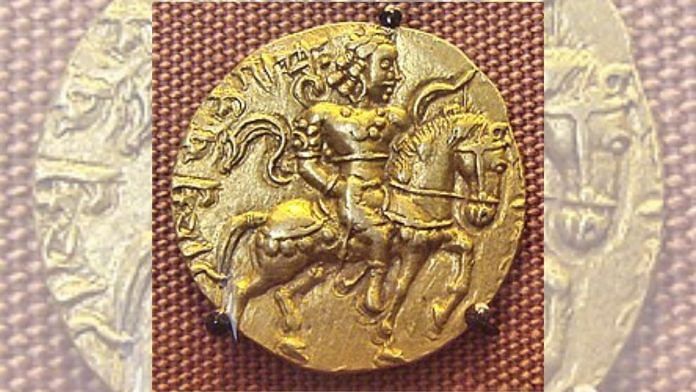As for Chandragupta’s actual life, the picture is less clear. Numismatist Sanjeev Kumar assembled the most concrete evidence available—coins—in Treasures of the Gupta Empire. Kumar demonstrates, by analysing the find-spots of treasure hoards, that Chandragupta’s father, Samudragupta (c. 335-375 CE), extended Gupta power from present-day eastern Bihar to eastern Madhya Pradesh. But Chandragupta was not his intended successor.
The prestigious territory around Ujjain, the most culturally sophisticated city in North India at the time, was ruled by the heir apparent Ramagupta. After their father’s death, Ramagupta quickly seized the imperial core territories and issued his own coins, however, these disappeared from the historical record within a year or two. They were replaced by Chandragupta’s coinage.
Some clues come from the Devi Chandraguptam, a Sanskrit drama composed about 200 years after the time of Chandragupta II. Though it survives only in fragments today, the play describes Ramagupta’s defeat by a Shaka or Indo-Scythian king Rudrasimha III, ruler of present-day Gujarat.
In the play, Rudrasimha III demands that Ramagupta hand over his wife, Dhruvadevi, in return for peace. Ramagupta accepts. His outraged younger brother, Chandragupta, decides to avenge this humiliation by disguising himself as the queen, entering the Shaka camp, and killing the king. Returning in triumph, he kills Ramagupta, takes the throne, and marries Dhruvadevi, his former sister-in-law.
In reality, Chandragupta II did have a queen called Dhruvadevi; he did indeed defeat and conquer the Shakas. But he did so at the end of his reign, not the beginning. His brother Ramagupta does not seem to have been defeated by the Shakas: he issued bronze coins commemorating a horse sacrifice, suggesting the opposite. Most scholars of the Gupta period, including SR Goyal and KK Thaplyal, agree that the Devi Chandraguptam may reflect the official version of the brothers’ fratricidal rivalry—which is to say, Chandragupta’s version.
This does not take away from Chandragupta’s success as a ruler. His conquest of the Shakas extended Gupta power from India’s West coast to the East, allowing for flourishing international trade. For nearly a century after Chandragupta II, his descendants dominated northern India.
Gupta emperors the Alchon Huns and lavished patronage on religious institutions. Many bore titles ending with ‘-aditya’, which may have inadvertently blurred them together in the popular imagination. In this time of literary and cultural ferment, various elements of Gupta history began to crystallise into a new, legendary figure: Vikramaditya.
The Gupta model of kingship involved martial, intellectual, and romantic connoisseurship, and a close relationship to the gods. The legendary Vikramaditya, representing all these values, could be picked up easily by composers and storytellers and adapted to new popular contexts. At the same time, the courtly ideas of the Guptas could be picked up by royals across the Indian subcontinent and beyond. Both these streams fed each other over the next 500 years.
Historian DC Sircar, in his magisterial Ancient Malwa and the Vikramaditya Tradition (1966), notes that the heroic King Vikramaditya first appeared in Buddhist legends from the late 6th century CE, when the Gupta dynasty was on its way out. In Buddhist texts such as the Vasavadatta of Subandhu, Vikramaditya is shown handing out lakhs of gold coins to teachers.
After the collapse of the Guptas, various other kingdoms picked up their ideas and titles, further enriching the evolution of Vikramaditya. Harshavardhana, king of Kannauj in the 7th century, spent his early career fighting the Alchon Huns, and used the title ‘Shiladitya’. Simultaneously, as noted earlier in Thinking Medieval, various were developing tantric rituals to guarantee a king’s victory. Perhaps not coincidentally, a new wave of Vikramaditya legends developed by the 9th and 10th centuries, depicting him participating in tantric rituals and conquering foreign enemies.
As state-builders, kings were also expected to display their ability to dispense justice; so Vikramaditya came to be involved in tricky, amusing challenges posed by ghouls. This figure, well-preserved in compendia such as the Kathasaritasagara of Somadeva, is much closer to the legendary Vikramaditya we know.
Interestingly, Vikramaditya was not always seen as a perfect hero, but a man with flaws. The Jain Deccan king Amoghavarsha I (814-879), in his Sanjan copper plate inscription, referred to Vikramaditya as “the despised donor of Kaliyuga of Gupta lineage, [who] having killed his brother… seized his kingdom and also his wife.” ( p. 235)
Amoghavarsha’s descendant, Govinda IV, praised Vikramaditya’s generosity and valour, but accused him of behaving cruelly with his brother, violating his brother’s wife, and propitiating vampires. Evidently, Jains were not the biggest fans of Vikramaditya.
But as Indian kingship continued to develop, so did the Vikramaditya legend. By the 11th and 12th centuries, palaces boasted large gatherings of poets, and kings patronised poets as much as priests. As such, recorded legends of Vikramaditya as the greatest of patrons, depicting their patron, the Chaulukya king Kumarapala (1143-1172), as a new Vikramaditya.
The great polymath and patron, Bhoja of Dhara (1010-1055), also linked himself to Vikramaditya in his writings. In popular legend, the two were eventually conflated. The most impressive attempt to claim the legend came from the Deccan. The Chalukya king Vikramaditya VI (1076-1126) declared, in his inscriptions, that he was starting a new calendrical era, the Chalukya Vikrama era, to “rub out” the legendary calendar said to have been established by Vikramaditya. Meanwhile, a vassal clan of his in North Karnataka renamed themselves the “Guttas”, declared their home “Guttavolal”, literally “Place of the Guptas”, called their chiefs “Vikramaditya”, and even claimed descent from “King Vikramaditya of Ujjain”. ()
In many ways, the figure of Vikramaditya shows us how the Sanskritic idea of kingship developed over the centuries. And he continued to have an appeal well after Muslim polities were established in the subcontinent. As Sircar points out, in the late 16th century, when North Indian Afghans attempted to drive out the Mughals, they were led by a Hindu bearing the name Hemu ‘Vikramaditya’—a direct nod to a legendary king believed to have driven out foreigners.
Immediately after, when Mughal Emperor Akbar reformed his court, he may have selected his “Nine Gems” to absorb Vikramaditya’s traditions. In the centuries after, Vikramaditya lost his political relevance, but flourished in popular imagination. If a royal deed needed doing, if curses needed to be undone, or riddles answered, Vikramaditya was your man.
Vikramaditya today is a somewhat different figure. A few years ago, I was most amused by a new meme map which coloured a good chunk of Asia saffron, declaring it “Vikramaditya’s empire”. Many now take this at face value, claiming that Vikramaditya, in fact, ruled Arabia and Europe.
It is one thing for a medieval storyteller to describe a legendary emperor as a world ruler; it is another thing entirely for an elected government to that Vikramaditya was a real figure who ruled over Iran, China and Turkey. While I sympathise with the need for deeper regional histories, this blind adulation of warrior kings actually erases these histories, substituting them for aggressively nationalist myths.
The clever, just, tricky Vikramaditya of legend is being eclipsed by a louder, shallower, but much more politically profitable version. Paradoxically, it appears that the king continues to represent the evolution of Indian rulership.
(Edited by Prasanna Bachchhav)








